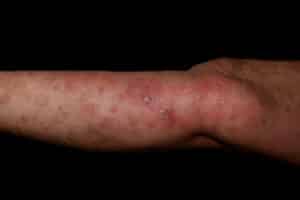Impetigo is a highly contagious infection in the epidermis or outer layers of the skin, primarily caused by Staphylococci bacteria. The diagnosis is clinical, but it’s critical to consider the patient history, your findings during a physical exam, and lab tests where necessary.
Impetigo in Patients
There are two forms of impetigo, known as nonbullous and bullous impetigo respectively. Nonbullous impetigo is the most common form, characterized by rupturing blisters. S. aureus is the primary cause, especially in the early stages, but Streptococci bacteria tend to dominate in the later stages.

Bullous impetigo, on the other hand, is caused solely by S. aureus and is most prevalent in infants and children. The bullae, or large fluid-filled blisters, appear as bacteria release toxins. Untreated or unresponsive bullous impetigo may develop into a deep ulcerated infection known as ecthyma.

Some children or adults with pre-existing skin conditions, such as atopic dermatitis, may be more prone to infections. Both forms often appear after a small break in the skin.
Key Clinical Clues of Impetigo
Impetigo may be easily mistaken for other diseases, but a few signs and symptoms can help you identify the condition. Patients may describe a painless itchy rash with red spots progressing to fluid-filled blisters. You may also see:
- Vesicles and pustules on the face, scalp, and hands
- Warm, red skin around the rash
- Thick, golden yellow crusted lesion over a red rash
- Enlarged and tender lymph nodes
- Mild fever
The golden-yellow crust is the tell-tale sign of impetigo. It appears as the blisters rupture and leak yellow pus that dries.
Differential Diagnosis
Impetigo may mimic some conditions. Consider the following in your differential diagnosis:
- Nonbullous impetigo
- Herpes simplex
- Pemphigus foliaceus
- Candidiasis (yeast infection)
- Scabies
- Shingles with blisters or crusts
- Tinea corporis (ringworm)
- Varicella (chickenpox)
- Bullous impetigo
- Pemphigus vulgaris
- Bullous pemphigoid
- Thermal burn
- Stevens-Johnson syndrome
- Bullous erythema multiforme
- Necrotizing fasciitis
Evidence-Based Treatment for Impetigo
Impetigo often clears with treatment within five days. However, early treatment is essential to prevent scarring, cellulitis, or hyper- or hypopigmentation.
Topical and Oral Antibiotics
Antibiotics are the primary treatment for impetigo. You can prescribe topical or oral antibiotics, though a topical form is as effective for mild or moderate impetigo with fewer side effects. Effective topical antibiotics include:
- Mupirocin cream
- Fusidic acid cream
You may need to combine topical antibiotics with oral for widespread infections, systemic symptoms, or family clusters. Oral antibiotics should cover group A beta-hemolytic Streptococcus and S. aureus. Effective oral medications include:
- Cephalexin
- Cloxacillin
If your patient has a penicillin allergy, consider the following:
- Azithromycin
- Clindamycin
- Sulfamethoxazole trimethoprim
- Doxycycline
If your community has known cases of MRSA or the rash doesn’t respond to treatment, take a swab to test for culture and sensitivity. Prescribe the oral antibiotics listed above for penicillin allergies with mupirocin cream, Polysporin triple therapy, or ozenoxacin 1% cream.
Hygiene
Impetigo is highly contagious and spreads through direct contact with the rash or contaminated personal items such as linens, towels, and facecloths. Encourage frequent handwashing with soap and water, and instruct patients to avoid touching their faces or sharing personal items.
Learn More With MDBriefCase
Impetigo is a common and often recurring infection. MDBriefCase offers many online and accredited courses on infectious diseases and other conditions to help you stay current on new evidence and best practices. Join for free today.
